Morocco, a land where the aroma of spice markets intertwines with the salty breeze of the Atlantic, is a country of dazzling diversity. Here, ancient cities sit alongside bustling modern streets, and the vast Sahara stretches out beneath a canopy of endless stars.
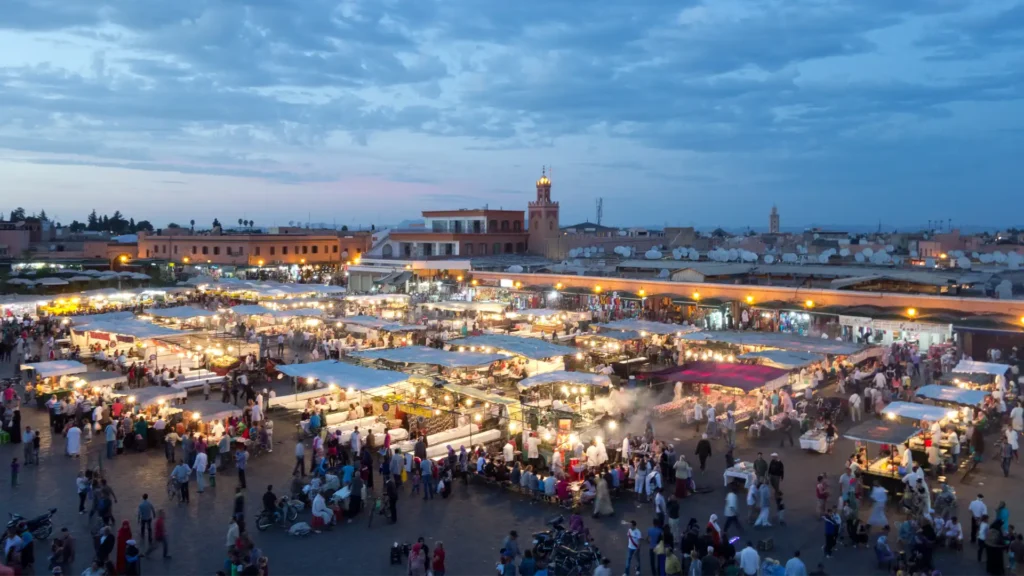
Marrakech, a city that buzzes with life, finds its heartbeat in the famous Jemaa el-Fnaa Square. As the sun dips below the horizon, this iconic square awakens, transforming into a bustling tapestry of culture and activity. Here, the air is rich with the scent of sizzling delicacies and the sounds of traditional Gnawa music.
Strolling through Jemaa el-Fnaa, one is greeted by a kaleidoscope of experiences. Snake charmers enchant with their hypnotic melodies, while storytellers captivate audiences with tales as old as the city itself. Nearby, rows of food stalls invite visitors to indulge in local flavours, from steaming tagines to sweet pastries dripping with honey.
But Jemaa el-Fnaa is more than just a spectacle; it’s a living piece of Moroccan heritage. Each evening, it becomes a social hub where locals and travellers alike gather, sharing stories and laughter under the starlit sky. The square, with its vibrant energy and rich history, is a microcosm of Marrakech itself – a city where tradition and modernity coalesce in beautiful harmony.
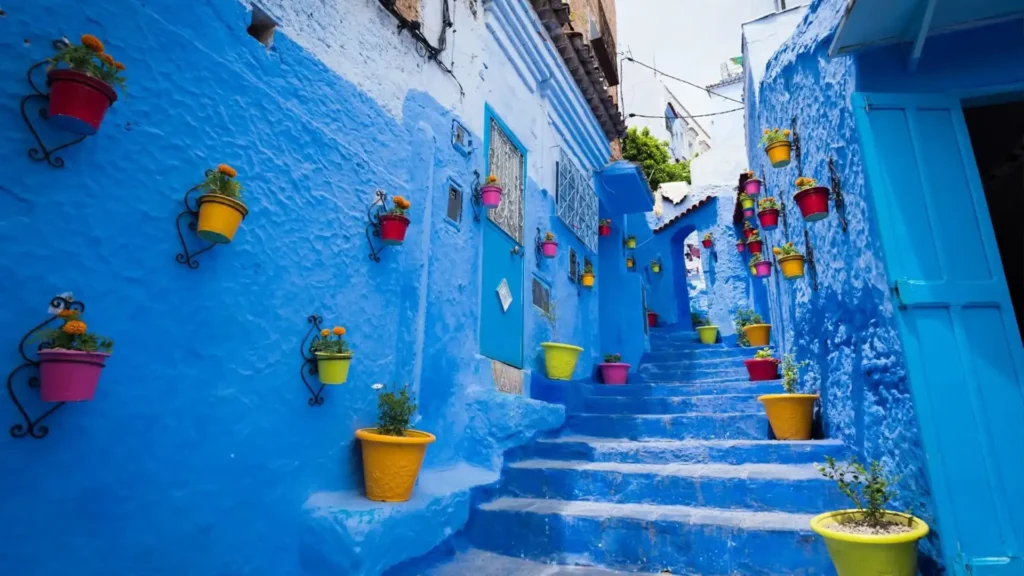
Nestled in the Rif Mountains, Chefchaouen is a dream woven in shades of blue. This tranquil city, with its streets bathed in azure, is a photographer’s paradise. The blue hues, ranging from sky to indigo, cover walls, doors, and even stairs, creating an ethereal, otherworldly charm.
Legend has it that the blue paint, originally used by Jewish refugees in the 1930s, symbolizes the sky and heaven, serving as a reminder to lead a spiritual life. Today, wandering through Chefchaouen’s narrow alleys offers a serene escape from the rush of the outside world. The colour blue, known for its calming effect, casts a soothing spell over the entire city.
Beyond its picturesque streets, Chefchaouen is a gateway to the natural wonders of the Rif Mountains. Hiking trails lead adventurers to cascading waterfalls and panoramic views.
Back in the city, small cafés and artisanal shops offer a taste of local life, where the warmth of the residents matches the city’s tranquil beauty. Chefchaouen, a blue gem in the heart of Morocco, is a place where peace and beauty reside at every corner.
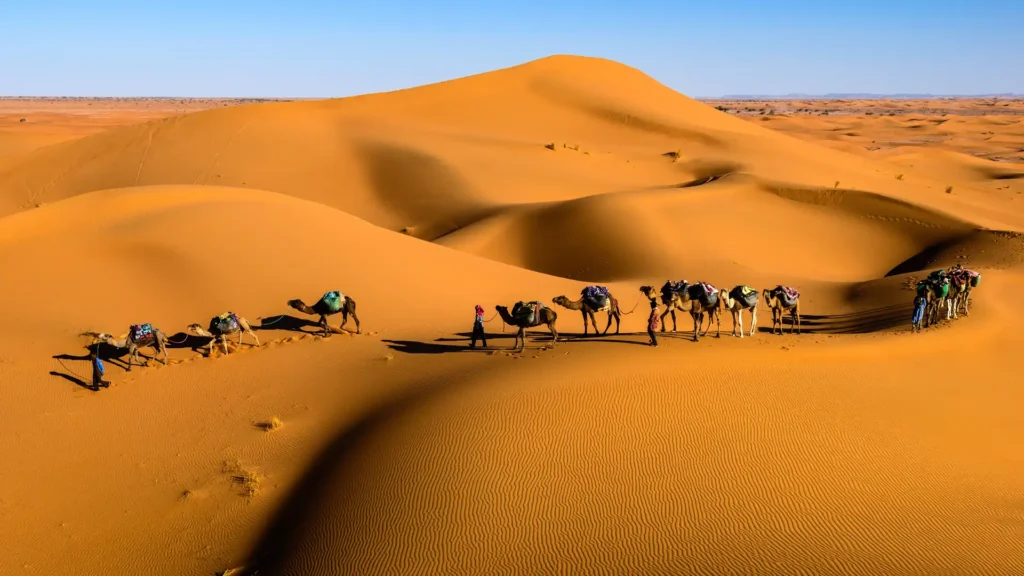
The Sahara Desert, a vast sea of golden sands, offers an adventure that is as boundless as the desert itself. This majestic landscape, stretching far beyond the horizon, changes its hues with the passing sun, from golden at noon to a soft pink at dusk. A journey into the Sahara is a journey into the heart of the wild, untamed spirit of Morocco.
One of the most magical experiences in the Sahara is a camel trek, where travellers can ride the ‘ships of the desert’ into the sunset. As night falls, the desert transforms under a blanket of stars, offering a night sky so clear and so filled with stars, it must be seen to be believed.
Spending a night in a traditional Berber camp, surrounded by the silent, moonlit dunes, is an unforgettable experience.
The Sahara is also a land of culture and history. Visits to local nomadic tribes provide insights into a life adapted to the desert’s harsh conditions. These encounters are heartwarming, marked by the sharing of mint tea and stories. The desert, with its endless sands and timeless allure, is not just a place but a journey into the soul of Morocco.
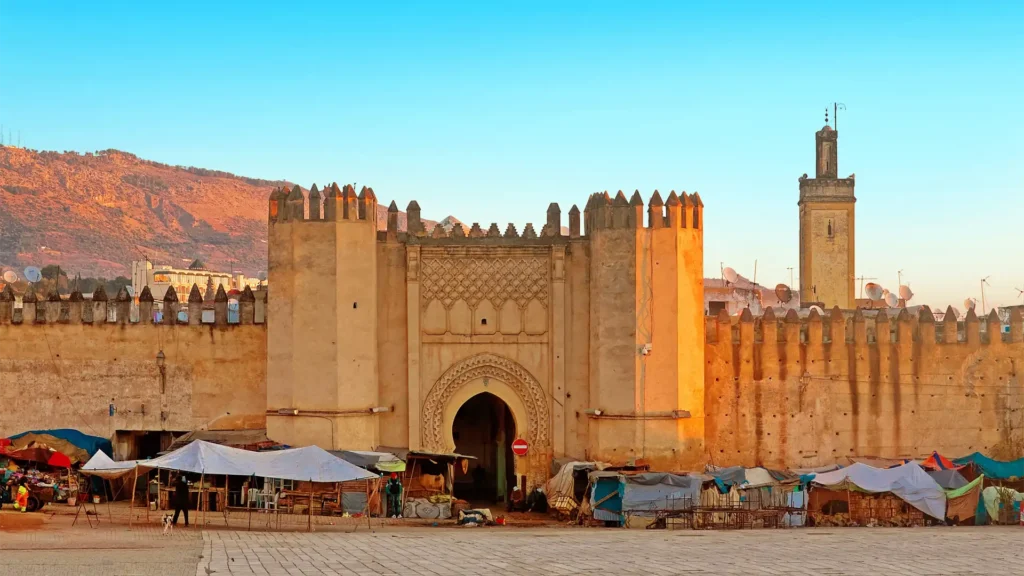
Fes, Morocco’s oldest imperial city, is a tapestry of history, art, and culture. Stepping into its ancient medina, Fes el Bali, is like stepping back in time. The city, a UNESCO World Heritage site, is a labyrinth of narrow, winding streets, alive with the rich scents of spices and the vibrant colours of Moroccan crafts.
At the heart of Fes’s historical charm are its tanneries, where the art of leather-making has been practiced for centuries. Visitors can observe this ancient craft from balconies above, watching as artisans skilfully transform raw hides into beautifully dyed leather.
The medina is also home to Al-Qarawiyyin University, founded in 859 AD and recognized as the world’s oldest continuously operating university.
Beyond its historical landmarks, Fes is a city of cultural depth. The melodies of Andalusian music fill the air in local cafes, while the city’s culinary scene offers a feast for the senses, from street food vendors to high-end restaurants. Every corner of Fes tells a story, from its bustling souks to its quiet, hidden gardens.
For travellers seeking a spiritual retreat, Fes’s many madrasas and mosques, adorned with intricate tile work and carved wood, offer moments of tranquillity. The city, with its blend of the ancient and the spiritual, is a testament to Morocco’s enduring cultural heritage.
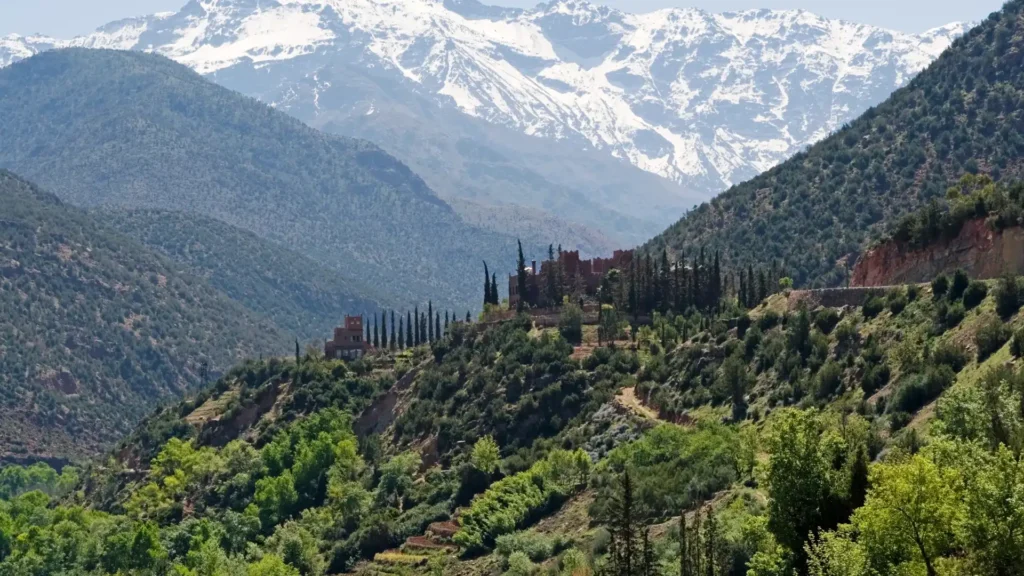
Rising above Morocco’s landscapes, the Atlas Mountains offer a world of natural beauty and cultural richness. These towering peaks, with their snow-capped summits and lush valleys, are a haven for adventurers and nature lovers. The mountains present a stark contrast to the country’s arid deserts and busy cities.
Hiking in the Atlas Mountains reveals the region’s diverse flora and fauna, with paths winding through almond and walnut orchards, and past cascading waterfalls. The mountains are also home to the indigenous Berber people, whose villages dot the landscape. These communities offer a glimpse into a way of life that has remained largely unchanged for centuries.
One of the highlights in the Atlas is the ascent of Mount Toubkal, North Africa’s highest peak. For those seeking a less strenuous experience, the region offers gentler walks through scenic valleys like Ourika and Imlil. Each trail unveils stunning vistas and the ever-changing colours of the mountains.
In addition to hiking, the Atlas Mountains are a gateway to a range of outdoor activities, including bird watching, mountain biking, and in winter, even skiing. The mountains, with their majestic beauty and cultural encounters, offer an experience that is both exhilarating and deeply humbling.
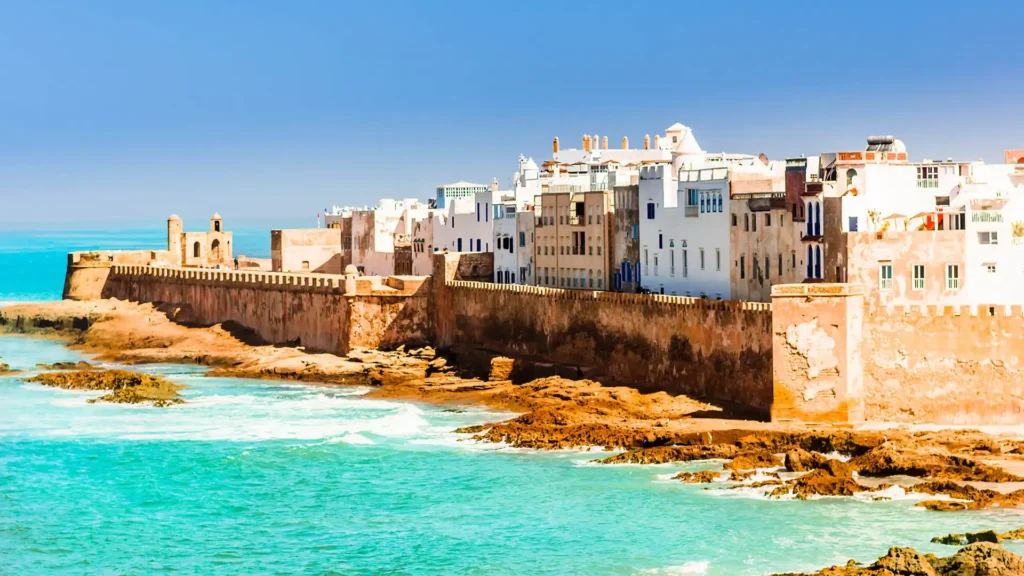
Essaouira, a port city on Morocco’s Atlantic coast, is a breath of fresh air compared to the country’s more frenetic cities. Known for its relaxed atmosphere, Essaouira’s charm lies in its blend of history, culture, and natural beauty.
The city’s medina, a UNESCO World Heritage site, is a maze of whitewashed houses interspersed with blue shutters, a visual reminder of its maritime heritage.
The city’s ramparts, which date back to the 18th century, offer stunning views of the Atlantic Ocean and have been the backdrop for numerous films. Strolling along the ramparts at sunset, one can watch local fishermen returning with their day’s catch, a daily ritual that connects Essaouira to its seafaring roots.
Essaouira is also known for its windsurfing and kite surfing, with the strong Atlantic winds providing ideal conditions for these sports. For those who prefer land-based activities, the city’s souks offer an array of local crafts, including beautifully crafted woodwork and intricate jewellery.
Beyond its physical beauty, Essaouira is a cultural melting pot, with an annual Gnaoua music festival that draws artists and enthusiasts from around the world. The city, with its laid-back vibe, artistic community, and stunning seaside setting, is a must-visit for anyone seeking a different side of Morocco.
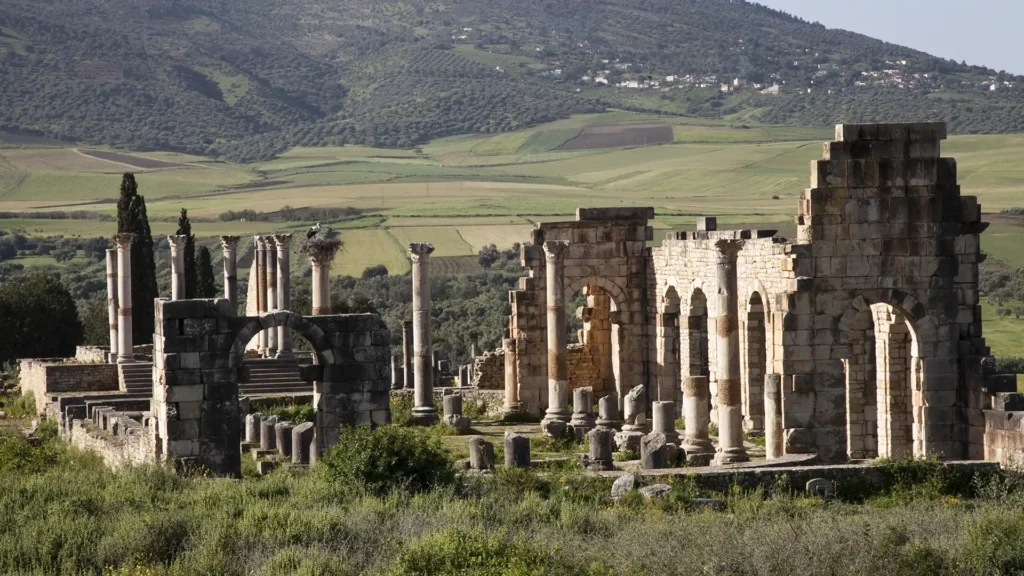
Volubilis, an ancient Roman city in Morocco, stands as a poignant reminder of the far-reaching arms of the Roman Empire. These ruins, set against a backdrop of rolling hills and open skies, offer a glimpse into a past where Roman and Berber cultures intertwined. The site, a UNESCO World Heritage location, is a testament to Morocco’s layered history.
A walk through Volubilis is like flipping through the pages of history. The city’s well-preserved mosaics, depicting scenes from Roman mythology, are among its most striking features. The Basilica and the Capitoline Temple, though partly in ruins, still reflect the grandeur that once defined this city.
What makes Volubilis special is the sense of tranquillity that pervades the site. Unlike many ancient ruins teeming with tourists, here one can often wander in solitude, contemplating the lives of those who walked these streets over two millennia ago. The silence is broken only by the gentle rustle of olive trees that dot the landscape.
The ruins also offer a spectacular view during sunset, when the golden light casts long shadows over the old stones, breathing new life into them. This magical time of day accentuates the site’s beauty and mystery, leaving visitors with a sense of awe at the passage of time and the endurance of history.
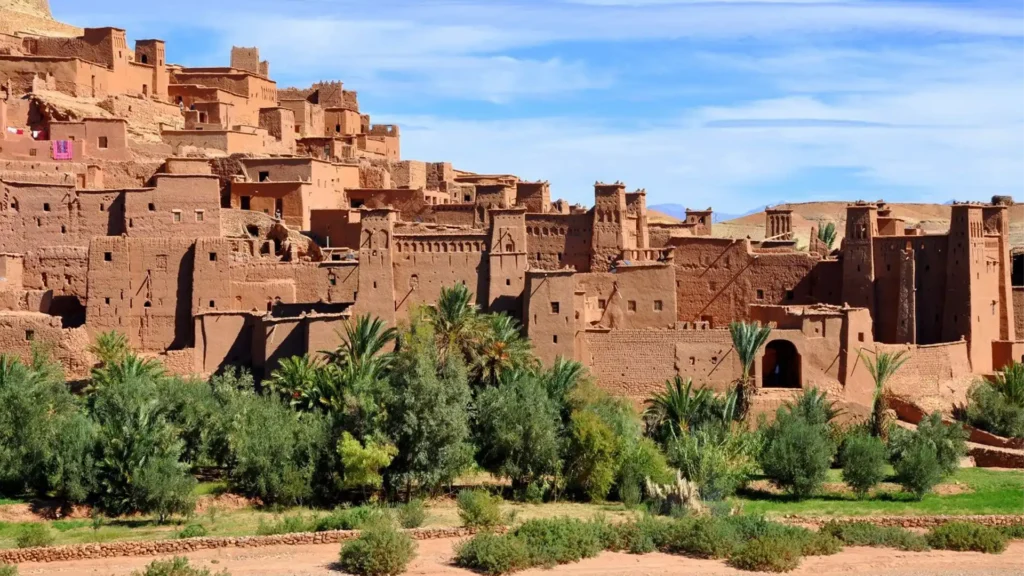
The Kasbah of Ait Benhaddou, a striking example of Moroccan earthen clay architecture, rises from the landscape like a mirage. This fortified village, or ksar, located along the former caravan route between the Sahara and Marrakech, is a vision of timeless beauty. Its earthen buildings, crowned by a backdrop of the Atlas Mountains, create a scene of dramatic beauty.
Ait Benhaddou’s fame extends beyond its historical and architectural significance, having been the filming location for numerous Hollywood movies. This has brought the Kasbah international recognition, but its charm remains rooted in its authenticity and the unchanged rhythm of life within its walls.
Exploring the narrow, winding paths of the Kasbah is an experience in discovery. Each turn reveals intricately decorated doors, small courtyards, and panoramic views over the surrounding arid landscape. The few families that continue to live here maintain the traditions of their ancestors, adding to the Kasbah’s living history.
Climbing to the top of the Kasbah provides a breathtaking view of the surrounding valley. The play of light and shadow over the landscape, especially at dawn or dusk, is a photographer’s dream. This UNESCO World Heritage site is not just a journey into Morocco’s architectural past but a step into a living, breathing piece of history.
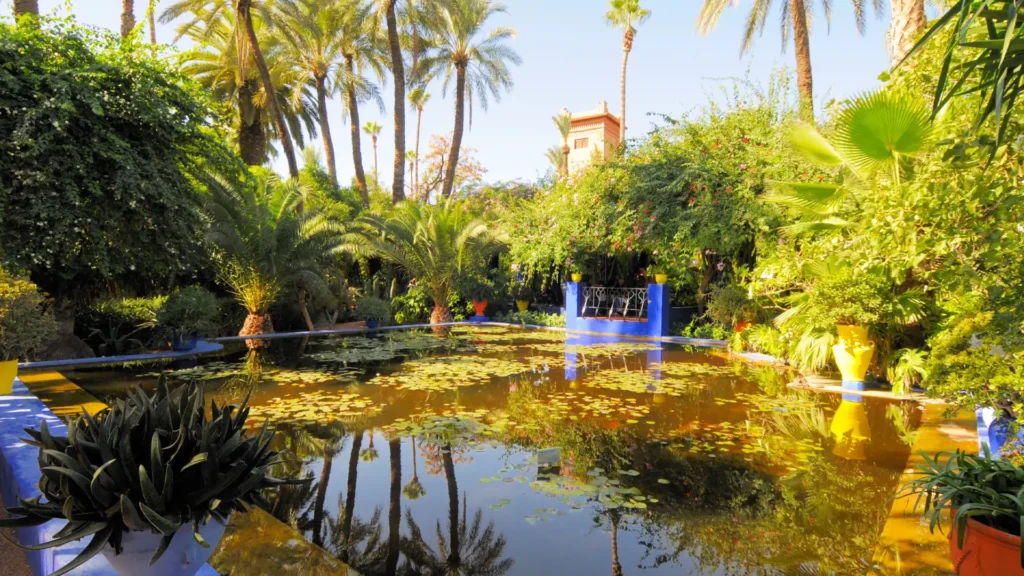
Majorelle Garden, a botanical and artistic oasis in the heart of Marrakech, is a world away from the city’s bustling streets. Created by French painter Jacques Majorelle in the 1920s and later owned by fashion designer Yves Saint Laurent, this garden is a masterpiece of landscape design and a tribute to the love of plants and colour.
The garden is renowned for its striking cobalt blue accents, known as Majorelle Blue, which vividly contrast with the lush greenery and vibrant flora. Wandering through the pathways, visitors encounter exotic plants from across the globe, tranquil streams, and serene ponds teeming with life.
More than just a garden, this place is a sanctuary for art and history enthusiasts. The on-site Berber Museum provides insights into the culture of Morocco’s indigenous people, while the Yves Saint Laurent Museum celebrates the designer’s work and his connection to Marrakech.
Visiting Majorelle Garden is not just about admiring its beauty; it’s about experiencing the peace that comes from being surrounded by nature and art. The garden, with its harmonious blend of architecture, botanical beauty, and cultural significance, is a tranquil retreat in the vibrant city of Marrakech.
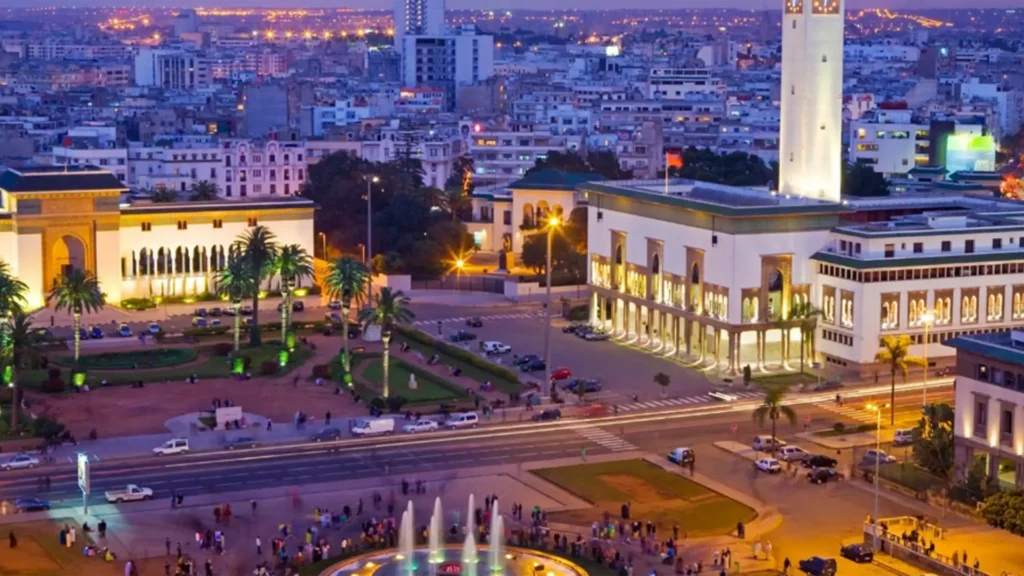
Casablanca, a city often synonymous with romance and mystery due to its cinematic namesake, offers a glimpse into contemporary Morocco. This bustling metropolis, the largest in the country, is a blend of modernity and tradition.
Skyscrapers and shopping malls coexist with historic architecture, providing a vivid picture of a nation striding confidently into the future.
The city’s crowning jewel is the Hassan II Mosque, an architectural masterpiece and one of the largest mosques in the world. Its minaret towers above the cityscape, while the mosque’s location, jutting out over the Atlantic Ocean, adds to its majestic presence.
The mosque’s intricate decor, which showcases the pinnacle of Moroccan craftsmanship, is open to non-Muslim visitors, offering a rare glimpse into Islamic art and architecture.
Casablanca is also a hub for art and culture in Morocco. The city’s numerous galleries and theatres showcase contemporary Moroccan art and performances, highlighting the country’s burgeoning artistic scene. The Quartier Habous, or New Medina, is a must-visit, blending traditional Moroccan design with French colonial influences.
For food enthusiasts, Casablanca offers a cosmopolitan dining scene. From upscale restaurants serving international cuisine to local eateries offering traditional Moroccan dishes, the city caters to all palates.
The bustling Central Market is a sensory delight, where locals shop for fresh produce, seafood, and spices. Casablanca, with its vibrant culture and dynamic energy, is the face of modern Morocco.